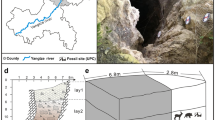Abstract
A new species of Tsaidamotherium (Bovidae, Artiodactyla), T. brevirostrum, described here represents only the second discovery of the genus. Tsaidamotherium is a mid-sized late Miocene bovid with an odd-looking plate-like horn-core apparatus so far known only from northwestern China. The holotype of T. brevirostrum is a cranial part of skull from the Liushu Formation (late Miocene) of the Linxia Basin. The new species differs from the type species, T. bohlini, mainly in horn-core morphology, having the frontal horn-cores proper much smaller and less distinctly separated from the plate-shaped posterior portion. Furthermore, the new species has smaller frontal sinuses, but a thicker layer of compact bone beneath the horn-core apparatus as seen in frontal section. A complete skull with a smaller horn-core apparatus is considered to represent a female individual of T. brevirostrum. The facial part of the skull, which is first known for this genus, is very short and high, with a high nasal cavity, strongly retracted nasals, and shortened premaxillae and premolar rows. All this probably suggests that the animal with an enlarged nasal cavity, like the modern Saiga and Budorcas, may have had a special adaptation to the high plateau environment.
Similar content being viewed by others
References
Bohlin B. 1935a. Cavicornier der Hipparion-Fauna Nord-China. Paleont Sin Ser C, 9: 1–166
Bohlin B. 1935b. Tsaidamotherium hedini, n. g., n. sp. Geografiska Annaler, 17: 66–74
Bohlin B. 1937a. Eine Tertiäre säugetier-fauna aus Tsaidam. Paleont Sin Ser C, 14: 1–111
Bohlin B. 1937b. Einige Bemerkungen über die Hörner der Ovibovinae. Bull Geol Inst Uppsala, 27: 42–47
Bouvrain G, de Bonis L. 1984. Le genre Mesembriacerus (Bovidae, Artiodactyla, Mammalia): un oviboviné primitif du Vallésien (Miocène supérieur) de Macédoine (Grèce). Palaeovertebrata, 14: 201–223
Chen G F, Zhang Z Q. 2009. Taxonomy and evolutionary process of Neogene Bovidae from China (in Chinese). Vert PalAsiat, 47: 265–281
Deng T. 2004. Sequence of the Cenozoic mammalian faunas of the Linxia Basin in Gansu, China. Acta Geol Sin, 78: 8–14
Deng T. 2005. Character, age and ecology of the Hezheng biota from northwestern China. Acta Geol Sin, 79: 739–750
Deng T, Qiu Z X, Wang B Y, et al. 2013. Late Cenozoic biostratigraphy of the Linxia Basin, northwestern China. In: Wang X M, Flynn L J, Fortelius M, eds. Fossil Mammals of Asia: Neogene Biostratigraphy and Chronology. New York: Columbia University Press. 243–273
Deng T, Wang X M, Ni X J, et al. 2004. Cenozoic stratigraphic sequence of the Linxia Basin in Gansu, China and its evidence from mammal fossils (in Chinese). Vert PalAsiat, 42: 45–66
Edinger T. 1939. The brains of three Pontian Ovibovinae from China. Bull Geol Inst Uppsala, 28: 133–140
Köhler M. 1987. Boviden des türkischen Miozäns. Paleont Evol, 21: 133–246
McDonald J N, Ray C E. 1989. The autochthonous North American musk oxen Bootherium, Symbos, and Gidleya (Mammalia: Artiodactyla: Bovidae). Smithsonian Contributions to Paleobiology, 66: 1–77
McKenna M C, Bell S K. 1997. Classification of Mammals Above the Species Level. New York: Columbia University Press. 631
Qiu Z X, Wang B Y, Xie G P. 2000. Preliminary report on a new genus of Ovibovinae from Hezheng District, Gansu, China (in Chinese). Vert PalAsiat, 38: 128–134
Simpson G. 1945. The principles of classification and a classification of mammals. Bull Amer Mus Nat Hist, 85: 1–350
Wang X M, Qiu Z D, Li Q, et al. 2007. Vertebrate paleontology, biostratigraphy, geochronology, and paleoenvironment of Qaidam Basin in northern Tibetan Plateau. Palaeogeography Palaeoclimatology Palaeoecology, 254: 363–385
Wu J Y, ed. 1990. The Chinese Takin (in Chinese). Beijing: China Forestry Publishing House. 192
Author information
Authors and Affiliations
Corresponding author
Rights and permissions
About this article
Cite this article
Shi, Q. New species of Tsaidamotherium (Bovidae, Artiodactyla) from China sheds new light on the skull morphology and systematics of the genus. Sci. China Earth Sci. 57, 258–266 (2014). https://doi.org/10.1007/s11430-013-4722-2
Received:
Accepted:
Published:
Issue Date:
DOI: https://doi.org/10.1007/s11430-013-4722-2




